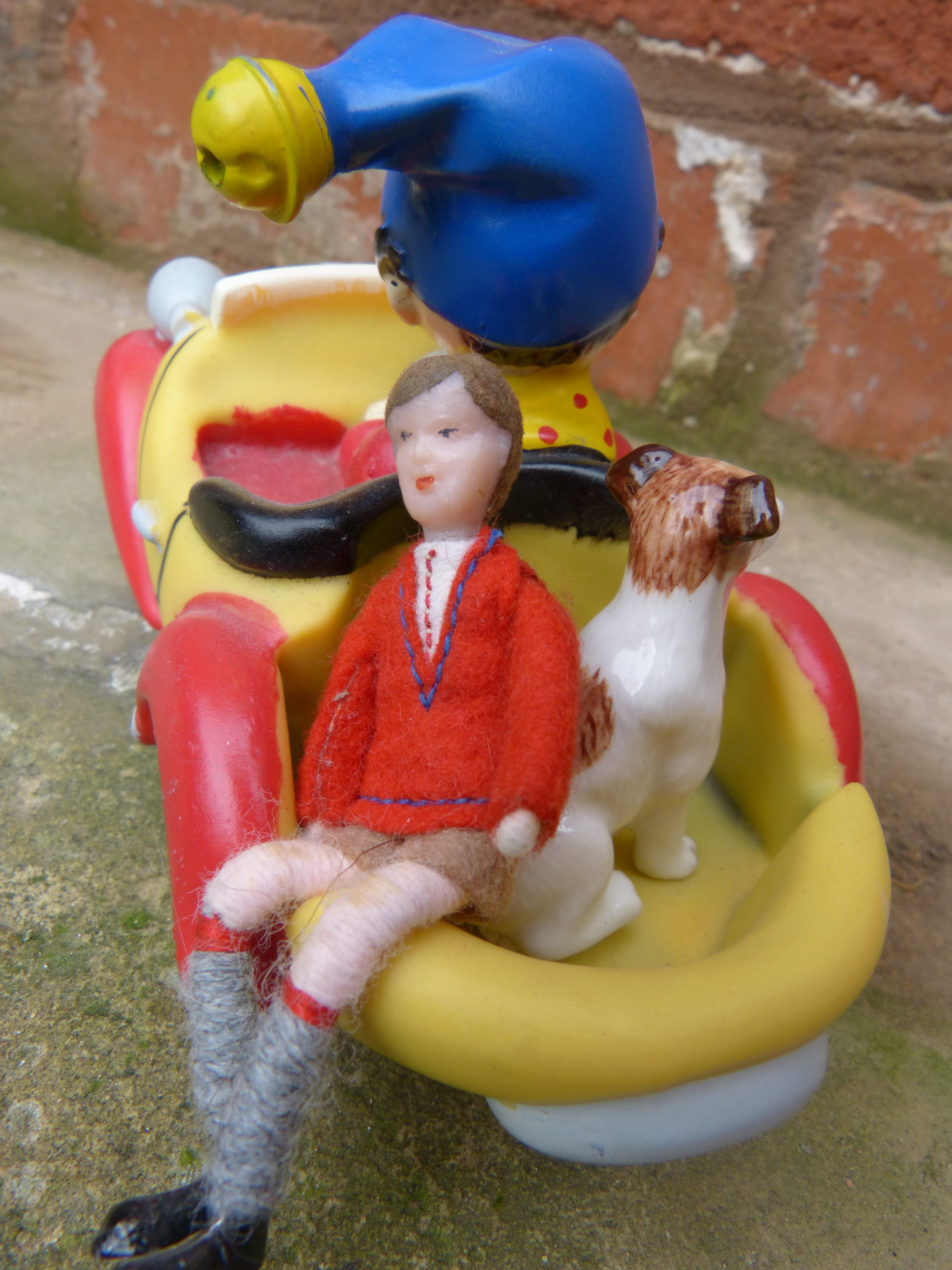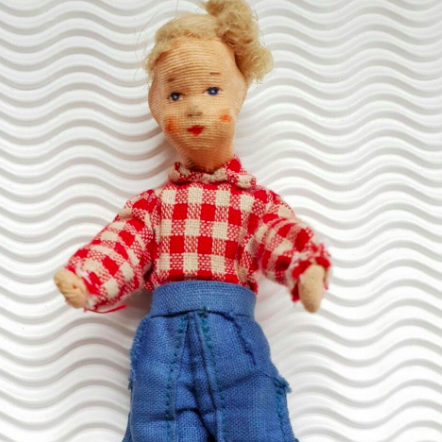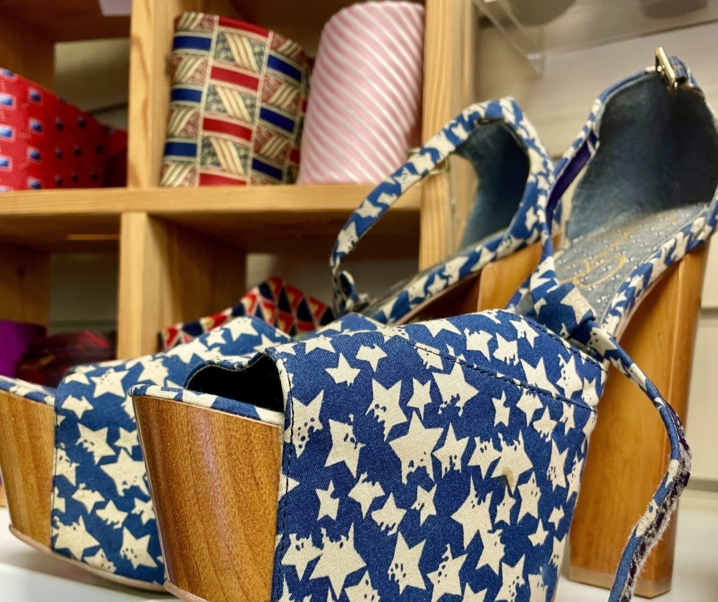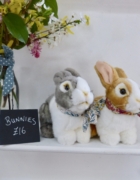To people, or not to people – now that is the question. As the owner of a completed dolls house, it’s a dilemma causing me a lot of existential angst.

In short, does my dolls’ house look nobler with my motley crew of miniature dolls (above) or without? Like a malevolent god or malicious bouncer I let them in, then throw out again. Just as I decide my 1980s Caroline’s Home mum (the woman in the sherry-drinker’s housecoat above) looks perfect with her tiny feet-up on my 1/12th scale coffee table, I traitorously think about listing her on eBay.

“It is a question of personal preference whether you like dolls in houses or not,” suggests Paige Baird, administrator of Vintage and Antiques Dolls House Collectors Club.
“I suspect it has to do with ‘realism’. Without dolls in a room you might think it was a real 1:1 room. Also there are many miniaturists who are aspiring interior designers and dolls don’t look realistic enough for their scenes. Personally I love dolls and have them in my houses – they bring them to life for me.”

Paige’s observations are borne out when I put the same question to Janet Parrella-Van Den Berg, interior designer, stylist and photographer who curates the elegant White & Faded on-line antique store.

On Janet’s sumptuous Instagram feed, she features her two dolls house projects (both made from kits) and it’s almost impossible to tell the real home from the miniature version.
“I loved to create a miniature world, I guess I just love interior design – small or large,” says Janet, who has devoted a whole chapter to her dolls houses in her new book Beauty Restored.
“I love the challenge of creating the perfect place.”
Dolls would be unwelcome guests; “I don’t like the look of them,” she tells me when I reveal my own ‘in/out’ dithering over dolls.
“I like dolls houses for their interior and not suggestive of a toy; I think that’s why.”

There’s a real sense of habitation in the award-winning house created by Jose Aleson. Lord Aleson – Jose’s Edwardian alter-ego – is part-way through a game of cards, while Lady Aleson has, says Jose, kicked off a pair of shoes and dashed off to a suffragette meeting. But it’s all done with the power of suggestion; never with dolls.
“If you see pictures of the house, you don’t know if it’s a miniature or not,” he told The Guardian in 2012.
“It’s like a mind-trick, it would be broken by a doll because a doll is not a real person.”
Putting the question of ‘dolls – yes or no?’ to the members of the Vintage and Antiques Dolls House Collectors Club on Facebook – do join; it’s fascinating – attracts a wide variety of views.

“It’s really just personal preference,” says Meg Dana who makes and restores vintage pieces for dolls houses and runs the very fabulous Instagram account dreaming_in_dollhouse.
“I usually don’t like dolls in my dollhouses because I feel like it takes away from the realism in my photography. That being said – I have done it.”

“I personally prefer my houses with lots of dolls and their pets,” says Jamie Hunt Vance whose collection of breath-taking vintage dolls include one which belonged to her own mother and dates from the 1920s.

“But I can also enjoy and appreciate others preferences too. That’s why I love being in the group, it opens your mind on what a dolls house can be.”
Often, the dolly debate will be influenced by nostalgic memories from when you were a little person.
“I was so lucky to grow up surrounded by dolls both big and small,” recalls group member Kaylin Beutel Caddis.
“I am in the process of fixing up my childhood dolls house which has been packed away for years, it has quite a few wonderful little dolls in it. I think little dolls in a dolls house are perfect.”
Ann Duston Rasmussen hits the nail on the head when she says it depends on the quality of the doll; “Sometimes I put dolls in, sometimes I don’t,” she explains.
“One house has a mermaid that lives in it.”


When I bought my dolls house’s shop, it was populated by so-called ‘realistic’ figures dating from the 1980s. The dolls were ghastly mock Victorian shop-keepers which – for all their retail know-how – only sold for a few pounds when I listed them on eBay. When I came to look for modern replacements, even the up-market porcelain dolls looked like something Dr Frankenstein would reject as not human enough.
“Don’t you just want to smash them?” laughs Nic Swan of the Vintage and Antique Dolls House Collectors Club.
“”As a child I had dolls in my house but, when I started back to having a dollhouse as an adult, a lot of the modern dolls just annoyed me.”
But, like me, Nic has been swayed by the whimsy of vintage and antique dolls; “I do get over my irritation when I see the old bisque dolls because of the history and the feel of them. They’re also a bit weird which means they began to enchant me. Ultimately, it’s totally up to the house owner to say yea or neigh to occupants of any sort.”

 So here’s the rub. A well-made Welsh dresser is a Welsh dresser regardless of the scale. But you cannot scale down a human. A tiny doll is always going to look like a tiny doll – so find ones you love enough to live with.
So here’s the rub. A well-made Welsh dresser is a Welsh dresser regardless of the scale. But you cannot scale down a human. A tiny doll is always going to look like a tiny doll – so find ones you love enough to live with.
For many, this means raiding the piggy bank to buy dolls which offer cute vintage charm; like the divine families produced with Swedish precision in the 60s and 70s by Lundby. You can forgive them their hunched Tommy Cooper “Just like that” shoulders and arms because their tattered ties and thread-bare knits are so darned cute.
If you are very lucky, you may be crafty enough to throw together a fairy or fawn using a bit of florist’s wire, clothes pegs and vintage lace (Etsy versions are available – see doll house sized bunny below – if you, like me, have thumbs for fingers).

Or you can swerve purpose-made dolls house figures completely. A quick glance at Instagram dolls houses (see some of my favourite accounts below) and dioramas created in boxes/shelves/old drawers etc) will show them over-run with all manner of miniatures including rubber Ari dolls, flirty-eyed Kewpies, tiny teddies and toy animals including mice and rabbits


A word of warning. As with many other hobbies with ‘antique’ or even ‘vintage’ in the title, your little hobby may not come cheap. A fact which has become clear to Vintage and Dolls House Collectors Club member Maria Marko, a relative new-comer to the dolls house scene. Maria guides me to an auction catalogue called ‘Small Courtesies’ which features a myriad of gorgeous bisque dolls from the collection of Evelyn Ackerman, an American industrial designer (the catalogue was published in 2013 by Theriault’s).
My favourites – a family of ten German bisque dolls pictured left – were valued by Theriault’s at $800-1,300 (£605-£984).
“I have always had dolls, but never had a dollhouse. I am new to collecting the antique dolls and dollhouses,” Maria explains.
“I do want small all-bisque dolls for a diorama I bought last month (February 2019) but…I can only afford one at a time. My diorama and any dollhouse I may get this year, may be empty until I can find, or afford the doll/ or dolls I want.”
Instagram sources: please not they are not dolls house accounts…they just feature extremely nice dolls houses.
Sue @yoyoandflo
Lisa @vintage_dahling
Naomi @swansfeet
Suzy @poppenhaus.suzy
Six of the best; since buying my dolls house in 2015 I’ve been wrestling with the question of whether or not to people it. I’ve decided that – if I’m going to go for it – I’ll do so with favourite figures one of the following brands. There are literally hundreds of vintage dolls house dolls out there and so I qualify this selection by saying these are my favourites.
Go find yours…..

Dolls house doll; Grecon
What? The artistic creation of would-be sculptor Margarete Cohn (b. 1894) – the name being letters from her name. According to an article in Toy Trader (1938), Miss Cohen began to make fun caricatures of her friends for a hobby. Although she was ‘not very interested’ when an artist suggested this would be a good business; Miss Cohen’s miniature wire wrapped with wool figures became hugely popular – and much copied. In 1936, Miss Cohen fled her home in Germany for England and registered her ‘Grecon’ trademark in 1940. According to collector and enthusiast Zoe Handy, Miss Cohen – known as Connie to her outworkers – was still making dolls at the age of 92.

Why? They are the perfect mix of cute and kitsch. The main body was simply twisted wire padded with cotton and bound with thread and/or wool. Colourful clothes were added to the figures which ranged from granddads to toddlers; Beefeaters to Bavarian hikers. Books could be devoted to the evolution of their size, shape, clothes and feet (the little metal shoes changing over time) but the bottom-line is…they are very desirable.
Rosemary Myers, known in collector’s circles as ‘The Grecon Queen’ wrote about her memories in Dolls’ Houses Past and Present.

“I have always loved Grecon dolls ever since I first came across them in a tiny folksy shop called “The Spindle”,” she wrote.
“The shop was run by a lady who seemed to know Margarete Cohn. Perhaps Miss Cohn delivered the dolls to her personally. I saved up all my pocket money carefully to create my first family – Norman, Mrs Norman and rather a lot of children.”
Where to buy? Grecons have been sold on eBay in the last month including a boy and girl (£20), Bavarian hiker boy (£31) and a granny and two toddlers (£31). Buyer’s beware; do visit websites like the one by Zoe Handy to do your homework – you will see a lot of figures online described as Grecon (?) which is often a sign they are anything but…

 Dolls house doll: Caco
Dolls house doll: Caco
What? Caco or CaHo was a trademark of German toymakers Canzier and Hoffman. In 1930, they began to make flexible dolls house dolls with composition heads, metal hands and feet and moulded hair. Like the Grecons, they were bound with thread. They were a hit. By the time of WWII, Caho were advertising 200 models. By 1952, the company had recovered from its war-time hiatus and – after a move to Coburg; – celebrated success with a new name Caco and the dolls were given more ‘relaxed’ hairstyles, high fashion threads and a separate thumb. Over the decades the faces become slimmer, the figures all plastic (mid-70s) but what remained were the fabulously observed fashions.

Why? The style which sees the women go from Agatha Christie dowagers in the 1930s to tailored Jackie O’ dames in the 1960s.
Where to buy? You can find dolls on eBay – expect to pay more for vintage in good condition like the sailor boy (metal hands – meaning pre-1964) who achieved £41.82 and a Caco chef £83.64. Later editions (all plastic) can be picked up for £8-plus. Many Caco models come from Germany so expect to pay an extra £6-7 postage. For details of their fashions try Dolls House Past and Present.

Dolls house doll: Dol-Toi
What: British-made, quality toys. Lincolnshire residents of a certain age can recall Mr and Mrs Ibbotson setting up their dolls house factory in Stamford in the 40s. Even in the 60s and 70s it sounds ‘cottage scale’ methods were being used – pieces of completed doll’s furniture given to the machinists to copy, leading to a ‘lot of variation’. Which probably goes a long way to explain the appeal of the homespun cloth/wire toys made initially with a plaster head (followed by plastic in the 60s).

Why? The hard, plastic headed dolls have their loyal fans – and even nicknames – because they are quality dolls which have stood the test of time and the family groups (and their clothes) hark back to a time when it was always sunny and there was bread and marmalade for tea.

Where to buy? The company was based in England so there’s lot of reasonably priced Dol-Toi furniture available on on-line auction sites if you want to recreate granny’s parlour. However, the dolls can be pricey. A bride and groom sold on eBay recently for £19.59. Basic family groups are more affordable; parents and a little boy was snapped up for £9.99, a schoolboy (see mine at the top in the Noddy car) for £4. Early fabric pieces, rare figures – like the nurse – or dolls bearing the ‘Figertoi’ name will command higher prices.
All the figures shown were sold by KT Miniatures from Marion Osborne’s collection.

Dolls house doll; Lundby
What; This Swedish brand is such a favourite of adult collectors, you’ll find many a blog devoted to Lundby and even a Facebook page Lundby Lovers where members – many Scandinavian – pose their dolls and Lundby wares for the enjoyment of all; today for instance (March 25, 2019) you’ll find dolls polishing their brasses, having a tea-party and playing with parrots…

Lundby was founded in ‘Lundby’ village in 1947 but it became hugely popular in the 1970s for its stream-lined dolls house with its asymmetrical roof. Fully illuminated, with working drawers in the kitchen – some models even had a sauna. Lundby houses were on every little girl’s Christmas list and in their hey-day, the company were making 100,000 houses per year. Dolls for the house (available from 1974) were made with equal precision and panache – often in well-made clothes and with real-life wigs.

Why? Because, like all great companies, it started at a kitchen table with Grete Thomsen making dolls house furniture for her niece and the pieces were so good – the world wanted to buy them. The dolls are just so glam; while vintage Dol-Toi are more Coronation Street – 70s Lundby dolls are Alpen advert’ in looks.
The appeal of Lundby can be summed up by Lundby Lovers member Sara; “Having the dolls house makes me think I’m reliving my childhood all over again…it reminds me of the happiest carefree days of my life.”
Fellow enthusiast Dorothy Kramer also loved her little Lundby family; “They were easily bendable—which made them fun to pose around the dollhouse and out in the world,” she says.
“And they were dressed in very hip clothes for the time. And they have nice faces—I guess they looked like kids I would be friends with.”

Where to buy? On eBay, recent sales have included a Lundby lady in gingham smock for £5.99, a dad on a sofa for £20 and a turtle-necked boy for £6.

Dolls house doll; Barton/Caroline’s Home
What; Another post-war initiative, A. Barton and Co is reported to have been set-up to give demobbed soldiers much needed jobs. It began with furniture and expanded to include a ‘model home’. By the 1970s, the company began to make people and animals, including farm-yard sets.

The little family groups often included a very smart ma and pa – often in a tie and jacket and bandy-legged trousers. On the weekend, the 1970s would let his hair down (not literally; it was moulded) by wearing a sport’s coat. Quite often mums and little girls would be in cotton dresses with lace trims. Those Barton dolls were the very definition of suburban swells.
Why? The Barton brand (which segued into Caroline’s Home in 1975) were popular well into the late 80s (just to strain your brain even more; the company was taken over by Lundby in 1984) and so these little dolls are still relatively easy to find/affordable to buy. Because of their rubber construction, they can look as though they’ve rode into town on horse-back but it only adds to their nostalgic appeal.


Caroline’s Home dolls also featured a family unit with a life-like Caroline doll (one version came with a horse) with long blonde locks. Years on, it’s quite easy to spot Caroline’s Home figures according to fan Joy Haddow-Allen as the ageing rubber often changed colour; ‘They’ve become known at the Yellow People,” she laughs.

Where to buy? You can find Barton/Caroline’s Home family figures on eBay; the above family set cost just £5.83. The prices are slowly creeping up – a rare and mint condition gran and grandpa sold for £41 – but you can buy single figures from just £1 to a little more than £8. In other words, for the price of a coffee, this is your chance to own a little bit of dolls house history the last of these iconic brands, Caroline’s Home and the entire UK operation – ceased to be in the 1990s.

Dolls house doll; Erna Meyer
What; There’s a collection on 1960s Erna Meyer dolls being sold online (March 2019) and the description says they are in ‘wonderful vintage condition’. It seems they have been ‘kept away from children’ and behind glass for most of their 50-odd years. On the one hand it’s sad; dolls were made for children’s play. On the other….early Erna Meyer dolls are so beautiful; I’d hardly dare breathe on them, never mind handle them.
Erna Meyer (1924-1996) was a trained kindergarten teacher but registered to make ‘arts and crafts of dolls made of cloth’ in Munich in 1945. The business was reported to be staffed with Erna’s friends who – like Erna – struggled to find work after the war. Understandably, the first dolls were made from cheap materials like rags and flax moulded onto florist’s wire and their faces painted onto stockinette (traditionally used for underwear).
The beautifully hand-painted dolls proved popular for play because they were so easy to pose.

After a successful showing at the Nuremberg Toy Fair (1950) the dolls were promoted by legendary doll-maker Kathe Kruse (Kathe had an international reputation with her handmade, life-like dolls) and Meyer’s client based swelled. After Erna’s marriage, the doll factory expanded and the business eventually passed to their daughter, Gabriele John von Freyend. The dolls are around today, still beautiful but – as with most things – the early ones have more charm.

Why? Rebecca’s Collections blog (see above) discovered a leaflet advertising Erna Meyer dolls for sale in New York circa 1950s. In all honesty, in describing dolls from the 50s and 60s, I cannot do any better.
‘The most unusual dolls ever imported…winsome little people with beautifully expressive faces and flexible bodies they can bend to any position.’

The cost of the nurse and baby doll in the leaflet may sound give-away but economists calculate that $1 in 1950 would be worth $10 today; so that’s approximately $25 for the nurse and baby (£19). These cute wire-wrapped dolls were expensive then – and more so now. A little girl with baby doll is offered by Doll’s House Emporium at £35.99.
Where to buy? The price of Erna Meyer dolls will very much depend on the age. For vintage pieces (including 80s/90s expect) to pay from £3 for a small boy to £20 for adult doll in good condition. For earlier pieces – 50s and 60s – the price will be £20-100 depending on condition (being cloth, they don’t age well).
As a lot of the dolls are imported from Germany and the US; don’t forget to factor in the postage.

To people or not to people?
Sadly, my little dolls will be packing up their wee suitcases and heading off to eBay. I am a very cruel mummy and the simple truth it – in spite of all the warning from dolls house enthusiasts – I didn’t obey the very simple rule of scale. All my vintage Barton/Caroline’s Home 70s figures are too small for my Jolly Volley Vintage shop which is a kit made in the late ’80s (modern dolls house are typically 1/12th scale so do check if you’re wanting to populate with vintage dolls which are often smaller).
In short, I’m going to need bigger dolls.
Credits;
Thank you to all the patient members of Facebook groups for their help.












